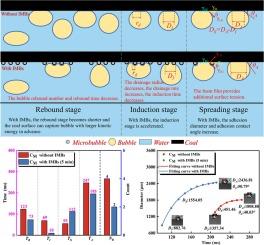Effect of in-situ microbubbles precipitated at the solid–liquid interface on the bubble-coal dynamic collision and adhesion processes
IF 7.5
1区 工程技术
Q2 ENERGY & FUELS
引用次数: 0
Abstract
The presence of interfacial microbubbles (IMBs) transforms the particle-bubble interaction process into a more complex particle-microbubble-floatation bubble system. Additionally, the high-speed collisions between deformable gas–liquid interfaces of different scales led to a higher level of physical complexity. However, there has been limited research on the particle-microbubble-floatation bubble interaction process. A high-speed camera was used in this study to investigate the precipitation and growth of IMBs on the coal surface in situ and to explore the impact of IMBs on the dynamic collision and adhesion processes. Observations of IMBs precipitation revealed that it was related to the air saturation in water. The precipitation sites were selective, mainly occurring from the pores and cracks on coal surface. As the precipitation time increased (from 2 to 60 min), the quantity of IMBs remained nearly unchanged, but their diameter and coverage rate increased, and the contact angle () decreased. Based on the frame-by-frame analysis of the dynamic collisions and adhesion processes between bubbles and coal surface, it was found that the bubble rebound number, rebound time, induction time and adhesion time all decreased in the presence of IMBs. Meanwhile, the kinetic energy () of the bubble that the coal surface can capture, adhesion diameter, and adhesion contact angle increased. The presence of IMBs can enhance the foam film drainage rate and form gas capillary bridges once the foam film ruptures, which helps the coal surface capture bubbles with greater and allows the bubble to enter the spreading stage more quickly. Additionally, the curved foam film formed between bubble and IMBs provides extra surface tension for the spreading of the three-phase contact (TPC) line. IMBs increase the probability and stability of bubble-coal adhesion. Furthermore, it was revealed that the microbubble morphology (diameter and contact angle) could affect the bubble-coal dynamic collision and adhesion processes. IMBs with a precipitation time of 5 min (diameter of 134 μm and of 47.1°) exhibited the best performance. This is mainly determined by the difficulty of bubble-IMBs coalescence, the increase in diameter after coalescence, and the possibility of consecutive coalescence. The findings of this study can provide new insights into using interface microbubbles to enhance the flotation yield and rate of coal particles, as well as to innovate flotation processes.

固液界面上析出的原位微气泡对气泡-煤动态碰撞和粘附过程的影响
界面微气泡(IMB)的存在将粒子与气泡的相互作用过程转变为更为复杂的粒子-微气泡-浮动气泡系统。此外,不同尺度的可变形气液界面之间的高速碰撞导致了更高水平的物理复杂性。然而,对粒子-微气泡-浮动气泡相互作用过程的研究还很有限。本研究使用高速相机对 IMBs 在煤表面的析出和生长过程进行了现场研究,并探讨了 IMBs 对动态碰撞和粘附过程的影响。观察发现,IMBs 的析出与空气中水的饱和度有关。析出部位具有选择性,主要发生在煤表面的孔隙和裂缝中。随着析出时间的延长(从 2 分钟到 60 分钟),IMBs 的数量几乎没有变化,但其直径和覆盖率增大,接触角(θm)减小。通过对气泡与煤表面的动态碰撞和粘附过程进行逐帧分析,发现有 IMB 存在时,气泡反弹次数、反弹时间、诱导时间和粘附时间均有所减少。同时,煤表面可捕获的气泡动能(EK)、粘附直径和粘附接触角都有所增加。IMB 的存在可提高泡沫膜的排水率,并在泡沫膜破裂后形成气体毛细管桥,这有助于煤表面捕获更大动能的气泡,使气泡更快地进入扩散阶段。此外,气泡和 IMB 之间形成的弧形泡沫膜为三相接触(TPC)线的扩散提供了额外的表面张力。IMB 增加了气泡与煤粘附的概率和稳定性。此外,研究还发现微气泡形态(直径和接触角)会影响气泡-煤的动态碰撞和粘附过程。沉淀时间为 5 分钟的 IMB(直径为 134 μm,θm 为 47.1°)性能最佳。这主要是由气泡-IMB 凝聚的难度、凝聚后直径的增加以及连续凝聚的可能性决定的。该研究结果可为利用界面微泡提高煤粒浮选产率和速率以及创新浮选工艺提供新的启示。
本文章由计算机程序翻译,如有差异,请以英文原文为准。
求助全文
约1分钟内获得全文
求助全文
来源期刊

Fuel
工程技术-工程:化工
CiteScore
12.80
自引率
20.30%
发文量
3506
审稿时长
64 days
期刊介绍:
The exploration of energy sources remains a critical matter of study. For the past nine decades, fuel has consistently held the forefront in primary research efforts within the field of energy science. This area of investigation encompasses a wide range of subjects, with a particular emphasis on emerging concerns like environmental factors and pollution.
 求助内容:
求助内容: 应助结果提醒方式:
应助结果提醒方式:


